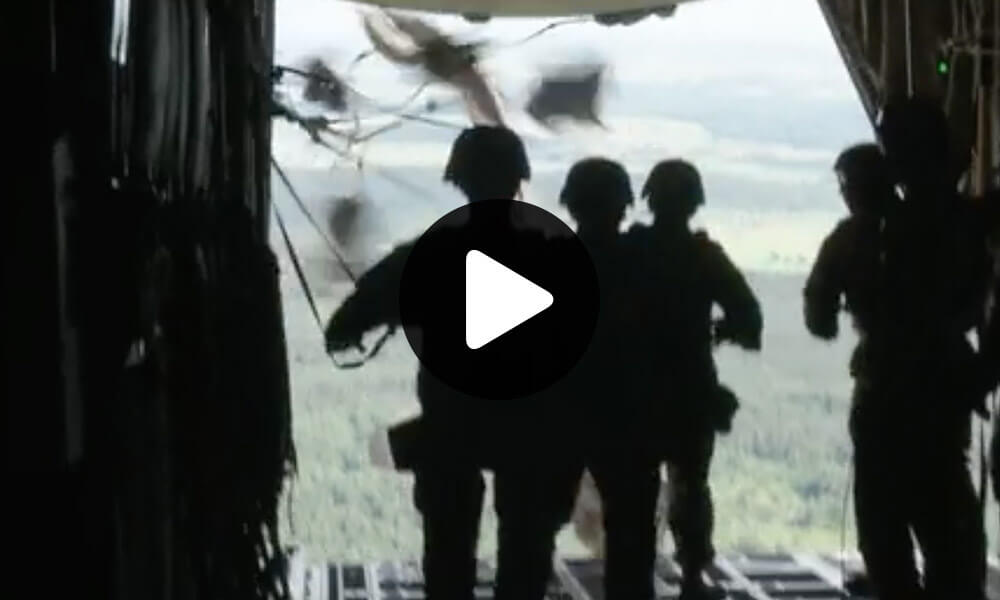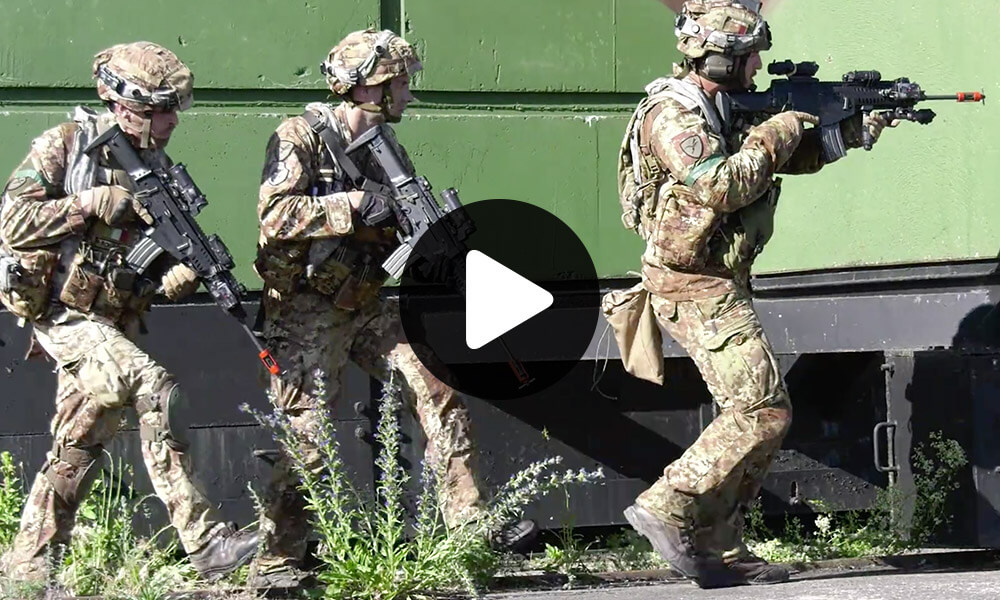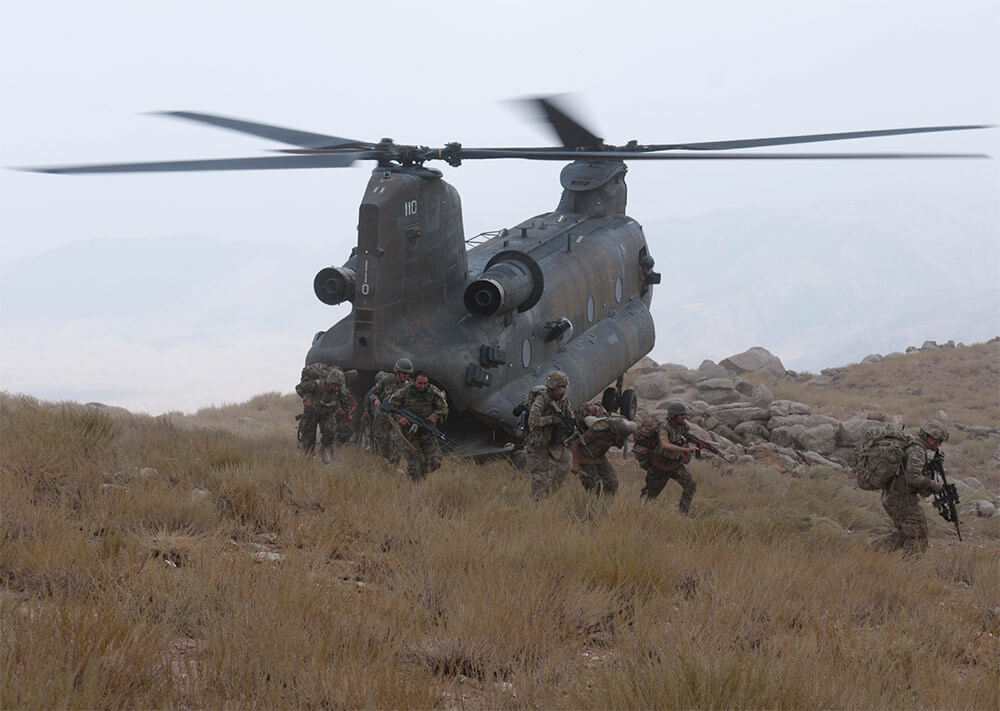Guard Soldiers Contribute to Multinational Exercises in Europe
Earlier this summer, National Guard Soldiers from across the country trekked through Europe for two related and equally significant events – exercises Saber Strike 18 and Swift Response 18.
The exercises provided realistic and relevant training held in dynamic environments. They also served to strengthen relationships with our Nation’s allied partners.
Exercise Saber Strike
More than 18,000 participants from 19 allied and partner nations participated in Saber Strike. This year marked the annual exercise’s eighth iteration with its four host countries: Estonia, Latvia, Lithuania and Poland.
“It is an opportunity for the U.S. Army to work with our coalition partners to increase interoperability and to understand the capabilities that NATO has to counter any threat to member nations,” said MAJ Fred McDaniel of the 678th Air Defense Artillery Brigade, South Carolina Army National Guard.

Army National Guard units from Illinois, Indiana, Kentucky, Michigan, Mississippi, Puerto Rico, South Carolina and Tennessee participated in the event. For two weeks, they worked in multi-lateral environments practicing complex combat techniques involving air, sea and land support. Saber Strike has an objective of simulating real-world deployment scenarios. The event included more than 60 UH/HH-60 Black Hawks, CH-47 Chinooks and AH-64 Apaches, all of which were used to provide close air support and air assault operations. Also deployed were more than 45 M1 Abrams Tanks and M2 Bradley Fighting Vehicles.
“The training that we get here is what we build up to all year long,” explained SFC Justin Aguilar, 143rd Infantry Regiment, Texas Army National Guard. “We are hitting all of our major gates and points to show that we are trained and efficient at what we do. It’s an evaluation for all of us – from my platoon all the way down to the rifleman – to see if we’ve been preparing properly. It helps us [to know that] we will be ready if the Nation calls and we are needed to succeed in combat.”

The exercise’s main events included force-on-force field training exercises, multiple bridging events and air assault operations, plus the movement of U.S. Army Europe (USAREUR)’s 2nd Cavalry Regiment from their home station in Vilseck, Germany, through the Czech Republic, Poland, Lithuania and Latvia.
Exercise Swift Response
Also taking place during Saber Strike was exercise Swift Response 18. Swift Response was an associated event held in Latvia, Lithuania and Poland. In its fourth iteration, Swift Response included approximately 2,300 participants from seven participating allied and partner nations. Army National Guard units from Indiana, Kentucky, Maryland, Michigan, Mississippi, Pennsylvania, Puerto Rico, Tennessee and Texas took part in the exercise.
Swift Response included simultaneous airborne operations carried out by USAREUR’s 173rd Airborne Brigade going into Miroslawiec Airfield, Poland, and the 6th Polish Airborne Battalion going into the Drawsko Pomorskie Training Area in Poland.
Preparation and Melding
As both Saber Strike and Swift Response involved a large group of participants from multiple countries, U.S. Soldiers were required to account for a diverse set of cultures and procedures. In preparation, Soldiers used their time before the exercise to research and study for the upcoming training.
The Texas Army National Guard’s 1st Battalion (Airborne), 143rd Infantry Regiment was assigned to the 173rd during Swift Response and was joined by platoon- and company-sized elements from Israel, Italy and Portugal.
“Conducting a training exercise in Europe always presents unique challenges,” explained CPT Seth Coolbrith of the 143rd Infantry Regiment. “The training required leading up to the deployment is extensive. Every paratrooper is required to validate numerous training objectives before they arrive.”
Along with pre-deployment training, Mississippi Guard Soldiers devoted time to studying the locations of the exercise and the participants they would be working alongside.
“I worked to understand the organizations to build good relations with those we would need to train, lead and support,” said LTC Hugh McCallum of the 184th Expeditionary Sustainment Command of the Mississippi Army National Guard. “We spent many hours collecting data on the units and organizations in order to better support them.”

As the strategic logistics planner for Saber Strike 18, MAJ David Leiva of the 184th Expeditionary Sustainment Command was tasked with working with the large number of exercise planners coordinating the concepts, movements and critical details of the exercise.
“Due to the [multilateral] component of the exercise, our roles were to ensure multinational interoperability by identifying gaps and vulnerabilities to effectively enhance cooperation, understanding, coordination and unity of effort,” explained MAJ Leiva. “Working on a daily basis with officers of other nations who had a greater understanding of European customs, laws, regulations and capabilities was challenging. This was equally difficult with U.S. officers who were well-versed and experienced in the European theater. Ultimately, my learning curve was quite steep.”
To lessen some of the cultural barriers, MAJ Leiva made time to study various languages prior to the exercise and immersed himself within the local cultures while in Europe.
“I had to spend a lot of time learning about the different nations to provide context in terms of what plans may work and which would not,” MAJ Leiva continued. “This was the challenge I was looking forward to. I had brushed up on my French, Spanish, Italian, Portuguese and Russian while I was still in the United States. I revisited Army sustainment manuals and lessons I’d learned on previous European exercises on how to be an effective liaison officer.”
SGT William Szabo, 384th Military Police Company, Indiana Army National Guard prepared for Saber Strike by studying Poland. As a senior medic, SGT Szabo’s duty was to ensure the medical readiness of the company and to safeguard the Soldiers’ medical health while abroad. To do so, he studied Poland’s environment to prepare for potentially harmful wildlife.
“From a medical standpoint, I studied [Poland’s] dangerous snakes, insects and plant life so that I had a basis for my medical supply need,” explained SGT Szabo. “In the States, we have poison ivy and copper heads; [in Poland], you have the European adder and very different plants.”
The time the Guard Soldiers dedicated to learning about the various environments and participants helped support the efficiency of the exercises. While the exercise presented challenges, the challenges mimicked the real-life scenarios Soldiers must be ready to face.

“We have to develop relationships, define the common goal and learn to synchronize our efforts,” explained LTC McCallum. “This is a balancing act between the science of war as we crunch numbers to provide information and the art of war by coordinating through language and other barriers to provide steady and reliable sustainment to the warfighter. We must learn to adapt to this operational environment quickly to provide real-time mission command while troops and equipment move throughout the battlefield.”
As in any exercise, effective communication was a crucial element.
“Communication is the biggest challenge because it affects all sections,” said 1LT Pilar Rolon, commander for the 755th Military Police Company of the Puerto Rico Army National Guard.
To alleviate communication challenges, Soldiers took initiative to foster relationships with their counterparts. Michigan’s 125th Infantry Battalion took the opportunity to form new connections while working alongside fellow U.S. service members from the 1st Battalion, 6th Marines, the Norwegian Armed Forces and the British Royal Marines.
“Many Soldiers took it upon themselves to walk over and strike up conversations with both Norway and the [United Kingdom] to get to know their counterparts,” explained SFC Matthew Boyd, senior logistics NCO with Company D of the 125th. “They were enjoying the opportunity to work with different nations and with everyone, as we were in generally close proximity within the camp.”
SPC Eugene Gonzales, 544th Military Police Company, Puerto Rico National Guard praised the collaborative environment at Saber Strike despite the fact that it brought together soldiers from multiple units who had not previously worked together.

“Being able to experience this new training with units we’ve never encountered before – I’d say that partnership is above standard,” SPC Gonzales explained. “Everyone is communicating well. We are all one [front] – nobody is acting as an individual. It’s a great experience. I’m really honored to be here.”
The dynamic training environments present at both Saber Strike and Swift Response required Guard Soldiers to remain steadfast and ready to deal with changing circumstances and varying personnel.
“Saber Strike is an incredible exercise for Guard Soldiers because it forces the unit’s personnel to plan everything to exhaustion, and across many different partner nations, and with staff members of the Army Service Component Command and a Theater Sustainment Command,” MAJ Leiva said. “It’s rare that a Guard unit will have this type of interaction except during a deployment.”
The challenging degree of the exercise was also a benefit, as it contributed to the growth of Soldiers.
“As an Army, we have grown accustomed to established military bases throughout the world, and this was an opportunity for the 678th to experience more full-spectrum operations,” explained MAJ McDaniel of South Carolina’s 678th Air Defense Artillery Brigade. “This was not so much as a challenge as it was an opportunity to learn what can be accomplished with the resources on hand and exercise the ability to adapt to a quickly evolving situation.”
SGT Szabo said participating in Saber Strike gave him and his fellow National Guard Soldiers an opportunity to showcase their unique skillsets.
“It’s been a great training exercise,” he said. “It was a chance for us to shine and show the rest of the Army what the Indiana National Guard can bring to the table. We train hard during our drill weekends and our annual training. A lot of us also do the same thing on the civilian side so we were able to bring a lot to [the exercise].”
CPT Coolbrith highlighted how the training in Europe created an unmatched, hands-on learning opportunity for Guard Soldiers.
“I think this is a great opportunity to show the full capabilities of the Army National Guard while training in Europe,” explained CPT Coolbrith. “Every paratrooper conducted a Platoon Live Fire and the 1-143rd conducted a Joint Forcible Entry via Airborne Assault with the 173rd [Airborne] and NATO allies. I think this is one of the most unique opportunities for a National Guard Soldier.”

1LT Rolon highlighted the importance of these exercises in developing National Guard Soldiers, even if they did not attend the exercise.
“I appreciate that the National Guard is included in these exercises because we love to learn,” she said. “We utilize everything we learn, and what we learn here we can teach to our Soldiers in the States who are expecting us to bring our experiences back home.”
The Saber Strike and Swift Response exercises presented Army National Guard Soldiers with an incredible opportunity to enhance their readiness and interoperability with our allies and regional partners, while developing the skills necessary to effectively operate during a deployment.
“We enjoy what we do – that’s why we are here,” SFC Aguilar said. “We are in the Guard, but we get a lot of time to train. We take a lot of pride in how we train and how prepared we are for the next war if need be. It’s an awesome opportunity for us to come here and get good training while simultaneously getting to see a little bit of Europe.”
By Staff Writer Tatyana White-Jenkins


